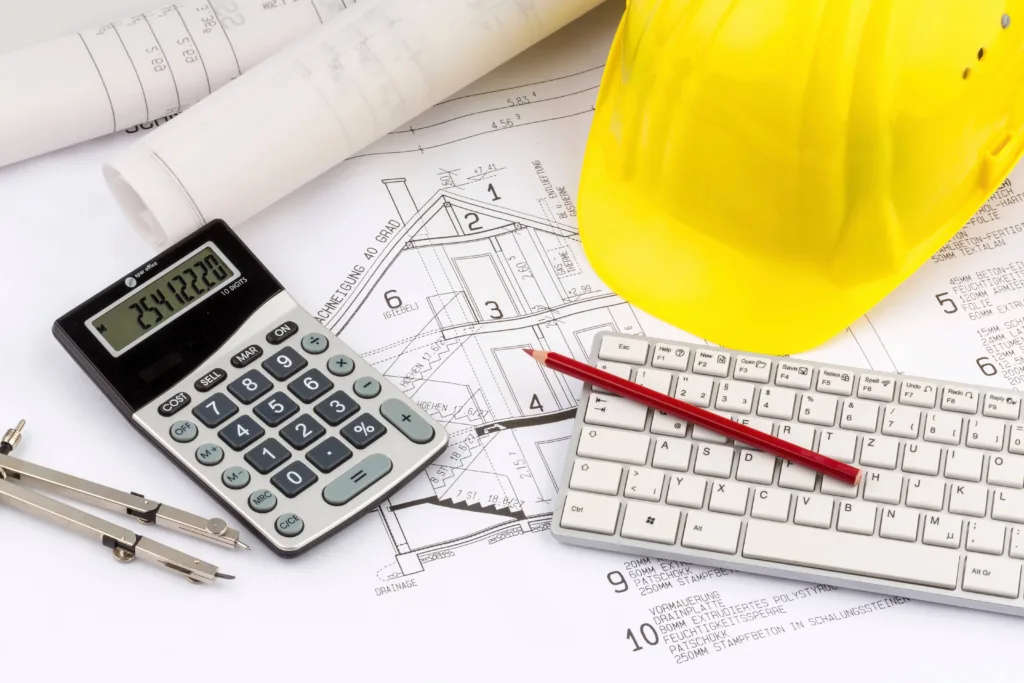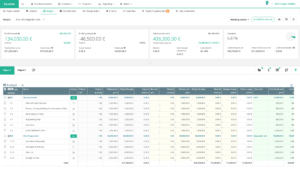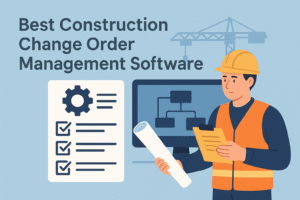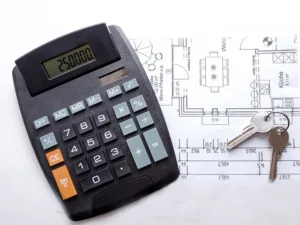In today’s fast-paced world, construction is one of the pillars of economic development and progress. Towering skyscrapers, intricate bridges, and sprawling urban complexes are testaments to human ingenuity and our desire to leave a lasting impact on the world. Behind these monumental achievements is the crucial realm of construction project management, a discipline dedicated to turning architectural dreams into tangible realities. One of its most vital components? The meticulous control and tracking of construction costs.
It might seem like a straightforward task: just keep an eye on the expenses, right? However, in the vast ecosystem of a construction project, it’s easy for costs to spiral out of control, leading to budget overruns, project delays, and dissatisfied stakeholders. So, why is tracking construction project costs so imperative? Simply put, it’s the backbone of ensuring the project’s financial health and keeping it on track from inception to completion.
Join us as we delve into the intricacies of construction cost management, its significance, and how it underpins the success of projects, big and small.
Table of Contents
1. Understanding Construction Project Management

At the heart of every architectural masterpiece or modest residential building lies a well-coordinated effort driven by a systematic approach: construction project management. But what exactly is it?
1. Definition: Construction project management is the comprehensive process of planning, coordinating, and controlling a construction project from conception to completion. It’s not merely about stacking bricks or pouring concrete, but rather it involves a delicate dance of aligning resources, schedules, budgets, and human expertise.
2. Key Components: A successful construction project is akin to a perfectly orchestrated symphony, and its key components comprise this orchestra’s individual sections.
- Scope: Defining what needs to be accomplished and, just as importantly, what doesn’t.
- Time: Mapping out a timeline to ensure the project proceeds according to schedule.
- Cost: This is where we get into the nitty-gritty of budgets, financial planning, and resource allocation.
- Quality: Ensuring that the project doesn’t just complete but does so at the standard set forth at the outset.
- Safety: Prioritizing the health and well-being of every individual on-site, from engineers to laborers.
- Communication: A two-way street that ensures all internal or external stakeholders are kept in the loop and can provide feedback.
3. Relevance: You might wonder, “Why can’t we just build?” But without construction project management, building endeavors would be akin to navigating uncharted waters without a compass. This discipline ensures projects are not just finished but are completed within a stipulated budget and timeframe and to the gold standard of quality we expect. Without it, projects risk going astray, both in terms of direction and finances.
In the context of our main discussion, understanding the cost component is pivotal. It’s not just about how much money is spent but where, when, and why it’s spent. And that’s what we’re diving into next.
2. Breaking Down Construction Costs

When we gaze upon the facade of a freshly constructed building, we often marvel at its design, the materials used, or its architectural significance. Rarely do we take a moment to contemplate the myriad of costs behind such an edifice. Yet, to truly grasp the importance of tracking these expenses, we must first understand their intricacies.
1. Direct Costs: These are the expenses most people think of when considering the cost of construction.
- Labor: The heartbeat of any project, labor costs account for the wages of the skilled and unskilled workers who breathe life into architectural blueprints.
- Materials: From steel beams to ceramic tiles, these are the tangible components that make up the structure.
- Equipment: Think of the cranes soaring above skyscrapers or the bulldozers shaping the earth. This category includes rentals or purchase costs for these essential machines.
- Services: This can encompass subcontracted tasks, such as electrical or plumbing work requiring specialized expertise.
2. Indirect Costs: Lurking beneath the surface, these are costs not directly tied to the physical construction but are just as vital.
- Administration: The expenses linked to office operations, salaries of supervisory staff, and other back-end functions.
- Security: Ensuring the safety of the construction site, its materials, and machinery.
- Quality Control: The procedures and personnel in place to guarantee that the work meets set standards.
- Temporary Structures: These include makeshift offices, storage facilities, or any short-term structure essential for the construction process.
3. Miscellaneous Costs: Sometimes overlooked but always present, these often include:
- Licensing Fees: The costs associated with getting the necessary permits and licenses.
- Insurance: Protecting the project, workers, and stakeholders from potential unforeseen liabilities.
- Taxes: Inevitable and mandatory, depending on the region or country of construction.
- Contingencies: A prudent reserve for unexpected events. Whether it’s a sudden rise in material costs or unforeseen site challenges, it’s always wise to have a safety net.
Breaking down these costs provides us with a clearer lens through which we can view the entire construction process. It’s about more than just knowing how much is spent but understanding where every dollar or cent goes. This awareness is the first step in optimizing spending, maximizing efficiency, and ultimately ensuring the success and profitability of a construction project.
3. The Importance of Tracking Construction Project Costs
We’ve all heard the old saying, “Look after the pennies and the pounds will look after themselves.” Now, translate that philosophy into the vast world of construction, emphasizing that tracking project costs is a fundamental activity for maintaining a project’s financial health and ensuring budget adherence. It becomes evident why tracking every expense, big or small, is paramount. So, let’s delve into the reasons behind this meticulous financial vigilance.
1. Budget Adherence:
Every construction project begins with an envisioned project budget—a financial blueprint that dictates the course of action, emphasizing the importance of establishing and tracking it for budget adherence based on accurate cost estimates, including all project costs from initiation to closeout. Tracking costs ensures that this budget isn’t just a sheet of optimistic figures but a dynamic guide that aligns with real-time expenses, utilizing construction budgeting software for efficient tracking and analysis of ongoing costs.
2. Financial Forecasting:
Rome wasn’t built in a day, and neither are most construction projects. Over time, costs can fluctuate due to market changes, unexpected challenges, or shifts in scope. Project managers can anticipate these fluctuations by regularly monitoring expenses and adjusting strategies accordingly.
3. Resource Allocation:
It’s not just about how much money is available but where it’s most effectively spent. Tracking costs helps identify which areas of the project demand more investment and which ones can operate with less—ensuring maximum efficiency and efficacy.
4. Risk Management:
In construction, financial surprises are rarely pleasant. By closely monitoring expenditures, project managers can identify potential financial pitfalls early on and devise strategies to mitigate or even prevent them.
5. Performance Analysis:
Are we getting the bang for our buck? Continually monitoring costs against project progress provides insights into the efficiency of operations. It helps in identifying over-performers and under-performers, enabling timely corrective actions.
6. Stakeholder Communication:
Trust is a currency as valuable as money. Keeping stakeholders, be it investors, clients, or regulatory bodies, informed about the financial health of a project fosters confidence and transparency.
By now, it should be clear that tracking construction project costs isn’t merely a financial exercise—it’s the lighthouse guiding a project safely to its completion. Beyond the numbers, it’s about ensuring that every step taken is stable, sustainable, and in the best interest of the project’s longevity and success.
4. Tools and Techniques for Tracking Construction Costs

In a world where the pace of technological advancement is relentless, the construction industry isn’t being left behind. Gone are the days of relying solely on handwritten ledgers and manual calculations to keep tabs on project finances. Instead, we’re in an era where digital tools and tried-and-true techniques combine to offer precision, efficiency, and real-time insights. Let’s dive into some of the leading tools and methods revolutionizing construction cost management.
Construction companies are increasingly adopting these software solutions and cost control techniques, enhancing their ability to monitor costs and manage projects more effectively. This shift not only streamlines operations but also provides a competitive edge in financial planning and operational insights.
1. Software Solutions: The digital age has gifted project managers with an array of software designed to streamline cost management.
- Procore: A holistic construction management software encompassing everything from project management to financials.
- PlanGrid: Beyond its mobile construction blueprint features, PlanGrid offers cost-tracking and reporting tools.
- Buildertrend: Catering mainly to homebuilders and remodelers, this tool streamlines budgeting, bidding, and financial reporting.
2. Cost Control Techniques: Embracing modern tools is essential, but they’re most effective when underpinned by sound cost control techniques.
- Regular Audits: Routine financial check-ups can identify discrepancies early, ensuring the project remains on the right fiscal track.
- Cost Variance Analysis: By comparing actual costs against budgeted amounts, this technique helps pinpoint areas that may be overspending or underutilizing funds.
- Earned Value Management (EVM): A comprehensive approach that evaluates project performance by comparing the work planned vs. work completed and the budgeted costs vs. actual expenses.
3. Regular Reporting: Keeping all stakeholders in the loop is crucial. Regular financial reports—be it weekly, bi-weekly, or monthly—offer transparency and ensure that everyone involved is aligned with the project’s financial standing.
- Weekly or Monthly Financial Summaries: A snapshot of the financial health, showcasing the money spent, allocated funds, and projections.
- Progress Reports: An overview of where the project stands regarding completion and if it aligns with the anticipated financial benchmarks.
Leveraging these tools and techniques doesn’t just simplify cost tracking; it elevates it. When wielded correctly, they provide unparalleled insights, allowing project managers to foresee financial challenges, capitalize on opportunities, and ensure that every project, regardless of its size, is built on a solid financial foundation.
5. The Consequences of Not Tracking Costs Efficiently

While we’ve emphasized the importance of diligent cost tracking and its benefits, it’s equally crucial to understand the flip side. What happens when we let the reins of financial oversight slacken? The answer is the ripples of neglect can lead to significant setbacks, if not outright project failure. Here are the consequences that construction projects might face when costs are not tracked efficiently.
1. Budget Overruns: Arguably, the most apparent repercussion, an unchecked flow of expenses can quickly lead to surpassing the allocated budget. And when that happens, either more funds must be infused or compromises must be made—neither of which is ideal.
2. Project Delays: Without an accurate picture of financial health, ordering essential materials or paying subcontractors can stall. These financial hiccups, in turn, can lead to halts in the construction process, pushing completion dates further out.
3. Compromised Quality: When the coffers are strained, there’s often a temptation (or sometimes a necessity) to cut corners. This can result in choosing cheaper materials or rushing work, adversely affecting the final product’s quality and safety.
4. Stakeholder Distrust: Regular and transparent financial tracking keeps the project on track and instills confidence among investors, clients, and other stakeholders. In its absence, trust erodes, which can lead to strained relationships or even legal disputes.
5. Diminished Profit Margins: Profitability is a primary concern for commercial ventures. When costs spiral uncontrollably, the anticipated profit margins can shrink or transform into losses.
6. Reputational Damage: A company’s reputation is its most valuable asset in the construction world. Consistently going over budget or delivering sub-par projects due to inadequate cost tracking can tarnish a firm’s image, making it challenging to secure future contracts.
7. Increased Stress: This might sound trivial compared to the other consequences, but it’s noteworthy. When a project’s finances are not in order, it leads to undue stress for project managers, financial controllers, and other team members. This strain can impact team morale, well-being, and overall project efficiency.
In a nutshell, while tracking every expense might seem tedious, the consequences of neglecting this duty are far-reaching and detrimental. It’s a cautionary tale that underscores the saying: “A stitch in time saves nine.” In the realm of construction, a dollar tracked today can save countless more down the line.
6. Case Study: The Tale of Maple Ridge Condominiums
In the heart of downtown Ashton, a new housing project dubbed the “Maple Ridge Condominiums” was taking shape. Managed by Ashton Constructions, a reputable name in the industry, the project was initially heralded as a paragon of urban living.
The Dream: With 100 luxury units spread across a 20-story building, Maple Ridge promises panoramic city views, modern amenities, and an eco-friendly design. The budget was set at $50 million, with a completion timeline of 24 months.
Initial Success: The first six months were smooth sailing. With enthusiastic investors and a marketing campaign that resulted in half of the units being pre-sold, things seemed on track.
The Downfall: However, as the months progressed, subtle signs of financial oversight emerged. The finance team failed to integrate an advanced cost-tracking tool, relying instead on outdated manual methods. As a result:
- Labor costs soared as untracked overtime accumulated.
- Material orders were duplicated due to miscommunication and a lack of real-time updates.
- Temporary structures, meant to be short-term solutions, inflated costs as their use was extended way beyond planned durations.
The Repercussions:
- By month 15, the project was $10 million over budget.
- Delays became routine as suppliers halted deliveries due to unpaid invoices.
- Investors grew restless, demanding updates and expressing concerns over the company’s ability to deliver.
- The quality took a backseat as the team scrambled to cut costs wherever possible, resulting in inferior unit fixtures and finishes.
The Aftermath: Maple Ridge Condominiums eventually saw completion but eight months behind schedule and $15 million over budget. The final product was a shadow of what was initially promised. Several investors pulled out, many units remained unsold, and Ashton Constructions faced legal battles and a tarnished reputation.
Reflection: The story of Maple Ridge is not one of a flawed vision but rather an example of the catastrophic consequences of neglecting diligent cost tracking. It serves as a potent reminder of the foundational importance of financial oversight in construction.
7. Best Practices in Tracking Construction Project Costs
Tracking construction costs goes beyond just crunching numbers. When approached correctly, it’s a strategic endeavor that can pave the way for seamless execution and financial transparency. Let’s explore some best practices that have stood the test of time.
1. Integrate Technology: We’re in a digital age, so leverage it. Utilize construction management software, which tracks costs and integrates them with project timelines, resources, and communication.
2. Regular Check-ins: Don’t wait for month-end to evaluate costs. Regular check-ins, whether weekly or bi-weekly, can help identify anomalies or inefficiencies early, allowing for timely interventions.
3. Collaborative Approach: Costs aren’t just a financial department’s responsibility. Engage site supervisors, project managers, and procurement teams in the cost-tracking process, ensuring a holistic and accurate understanding.
4. Detailed Breakdowns: Instead of lumping costs into broad categories, aim for detailed breakdowns. This granularity can highlight specific areas where costs may spiral and offer deeper insights.
5. Contingency Planning: It’s construction—unexpected costs are par for the course. Always have a contingency budget in place, but more importantly, monitor it as diligently as the primary budget to avoid unnecessary spending.
6. Vendor Negotiations: Regularly revisit contracts and agreements with vendors and subcontractors. Periodic negotiations or even bulk deals can lead to substantial cost savings.
7. Employee Training: Ensure that every team member understands the importance of cost tracking. Offering training on tools, software, and best practices can align everyone toward the financial objectives.
8. Transparent Reporting: Make cost tracking and reporting transparent to all stakeholders. Regular communication ensures everyone is aligned and can build trust, especially when challenges arise.
9. Revisit and Revise: Just because a method or tool worked for one project doesn’t mean it’s a one-size-fits-all solution. Continuously revisit cost-tracking strategies, learn from past projects, and strive for improvement.
1o. Celebrate Milestones: Positive reinforcement goes a long way. Celebrate when projects remain within budget or when financial challenges are adeptly navigated. This not only boosts team morale but reinforces the importance of diligent cost management.
In essence, tracking construction project costs is as much about mindset as it is about methods. Adopting a proactive, strategic, and collaborative approach, underpinned by these best practices, can guide any construction endeavor toward financial success and operational excellence.
Conclusion
Navigating the intricate web of construction management, with its myriad tasks, timelines, and resources, is no walk in the park. But as we’ve delved into today, at the heart of this challenging journey lies the crucial responsibility of tracking construction project costs. From understanding the foundational role of construction project management to confronting the real-world consequences of neglecting financial oversight, our expedition underscores one unyielding truth: meticulous cost tracking is not just advisable; it’s indispensable.
Incorporating state-of-the-art tools, adopting best practices, and fostering a culture of financial diligence can distinguish between a project’s resounding success and its unfortunate downfall. But beyond the tools and tactics, there’s a more profound takeaway. At its core, diligent cost tracking is a testament to a project’s commitment to transparency, quality, and accountability.
For construction professionals, stakeholders, and investors, Maple Ridge Condominiums’ cautionary tale reminds us of the stakes at play. As we forge ahead, building the skylines of tomorrow, let’s ensure that our edifices stand not only on solid ground but also on the bedrock of financial prudence and precision.
In wrapping up, the essence of construction is not just to create structures but to sculpt dreams. And for these dreams to truly flourish, they must be nurtured with care, dedication, and an unwavering eye on the financial pulse.
About the Author

Mikk Ilumaa
Mikk Ilumaa is the CEO of Bauwise, a leader in construction financial management software with over ten years of experience in the construction software industry. At the helm of Bauwise, Mikk leverages his extensive background in developing construction management solutions to drive innovation and efficiency. His commitment to enhancing the construction process through technology makes him a pivotal figure in the industry, guiding Bauwise toward setting new standards in construction financial management. View profile






